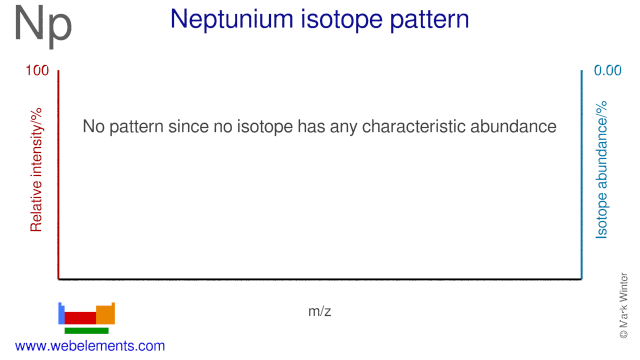Neptunium - 93Np: the essentials
- Name: neptunium
- Symbol: Np
- Atomic number: 93
- Relative atomic mass (Ar): [ 237 ] (longest lived isotope)
- Standard state: solid at 298 K
- Appearance: silvery metallic
- Classification: Metallic
- Group in periodic table:
- Group name: Actinoid
- Period in periodic table: 7 (actinoid)
- Block in periodic table: f
- Shell structure: 2.8.18.32.22.9.2
- CAS Registry: 7439-99-8
Neptunium atoms have 93 electrons and the shell structure is 2.8.18.32.22.9.2. The ground state electronic configuration of neutral neptunium is [Rn].5f4.6d1.7s2 and the term symbol of neptunium is 6L11/2.
Neptunium: description
Neptunium is a radioactive rare earth metal and has at least 3 allotropic forms. It is named for the planet Neptune. Np-237 is a by-product from nuclear reactors.
Neptunium: physical properties
Density of solid: 20450 kg m-3
Molar volume: 11.59 cm3
Thermal conductivity: 6 W m‑1 K‑1
Neptunium: heat properties
Melting point: 910 [637 °C (1179 °F)] K
Boiling point: 4300 [ca. 4000 °C (7232 °F)] K
Enthalpy of fusion: 20.5 kJ mol-1
Neptunium: atom sizes
Atomic radius (empirical): 175 pm
Molecular single bond covalent radius: 171 (coordination number 3) ppm
van der Waals radius: [ 270 ] ppm
Neptunium: electronegativities
Pauling electronegativity: 1.36 (Pauling units)
Allred Rochow electronegativity: 1.22 (Pauling units)
Mulliken-Jaffe electronegativity: (no data)
Neptunium: orbital properties
First ionisation energy: 604.53 kJ mol‑1
Second ionisation energy: 1110 kJ mol‑1
Third ionisation energy: 1900 kJ mol‑1
Neptunium: abundances
Universe: (no data) ppb by weight
Crustal rocks: (no data) ppb by weight
Human: (no data) ppb by weight
Neptunium: crystal structure

Neptunium: biological data
Human abundance by weight: (no data) ppb by weight
Neptunium has no biological role.
Neptunium: uses
Neptunium: reactions
Reactions of neptunium as the element with air, water, halogens, acids, and bases where known.
Neptunium: binary compounds
Binary compounds with halogens (known as halides), oxygen (known as oxides), hydrogen (known as hydrides), and other compounds of neptunium where known.
Neptunium: compound properties
Bond strengths; lattice energies of neptunium halides, hydrides, oxides (where known); and reduction potentials where known.
Neptunium: history
Neptunium was discovered by Edwin M. McMillan and P. H. Abelson in 1940 at USA. Origin of name: named after "the planet Neptune".Neptunium: isotopes

Neptunium: isolation
Isolation: coming soon!
